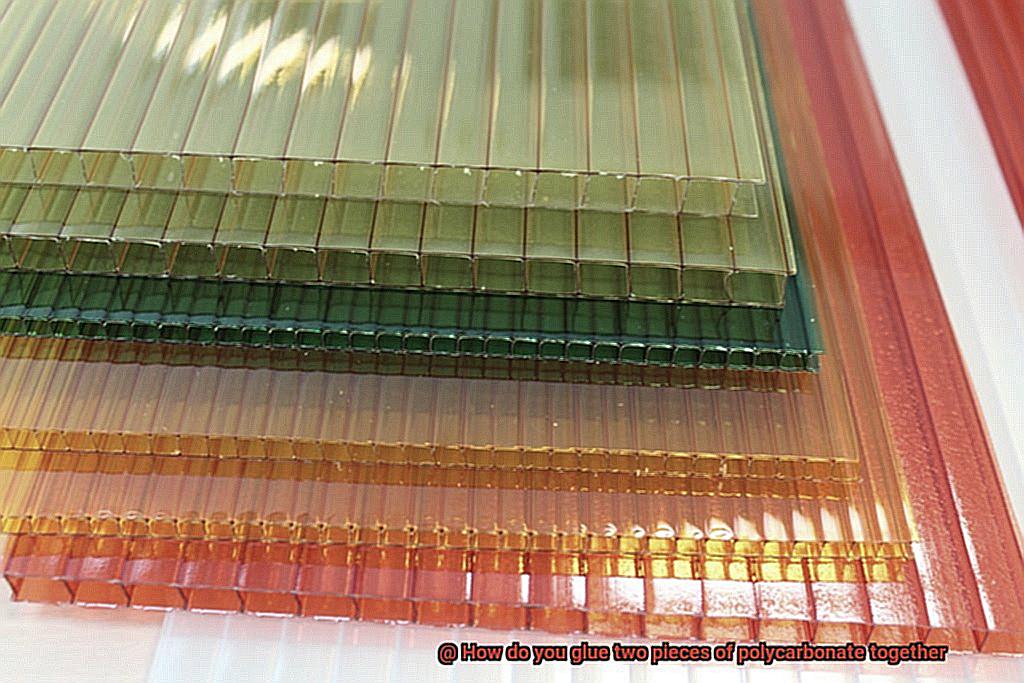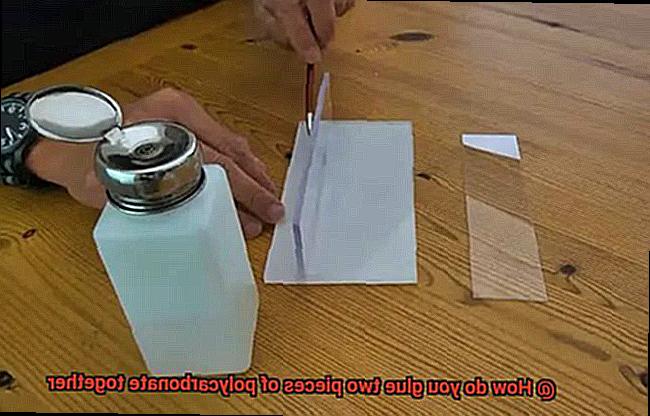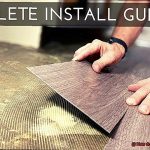If you’ve ever found yourself wondering how to glue two pieces of this incredible material together, then you’ve come to the right place. Polycarbonate is like the superhero of plastics – strong, transparent, and ready to tackle any project you throw at it. Whether you’re a DIY enthusiast or a seasoned pro in the manufacturing world, knowing how to bond polycarbonate properly is key.
In this guide, we’ll take you on a journey through the ins and outs of bonding polycarbonate. We’ll start by rounding up all the materials you need (don’t worry, it’s not rocket science), and then we’ll dive into the nitty-gritty details of achieving that flawless bond that will make your project stand out from the rest.
But wait, there’s more. We won’t just stop at telling you which adhesives work best with polycarbonate. Oh no, we’re here to share some top-secret tips and tricks that will take your craftsmanship to new heights. So get ready to embark on an adventure filled with bonding magic as we explore the wonderful world of polycarbonate gluing.
Let’s get started.
What is Polycarbonate?
Contents
Polycarbonate, a remarkable thermoplastic polymer, has revolutionized numerous industries with its exceptional properties. From safety equipment to bulletproof windows, this material offers a winning combination of strength, transparency, and resistance to extreme temperatures. In this article, we will delve into the fascinating world of polycarbonate, exploring its exceptional properties and wide-ranging applications.
Exceptional Strength and Impact Resistance:
Polycarbonate’s strength is truly remarkable, as it is approximately 200 times stronger than glass. This outstanding property makes it the top choice for applications that demand durability and protection against breakage. Its impact resistance ensures that it can withstand heavy blows without shattering, making it ideal for safety equipment like helmets and bulletproof windows.
High Transparency:
Despite its extraordinary strength, polycarbonate offers excellent transparency comparable to glass. This unique characteristic makes it perfect for applications where optical clarity is vital, such as eyeglass lenses or camera lenses. The ability to transmit high levels of light makes polycarbonate an exceptional choice for products requiring optimal visibility.
Resistance to Extreme Temperatures:
Polycarbonate exhibits an impressive ability to withstand temperatures ranging from -40°C to 120°C without deformation or structural damage.
This unique characteristic makes it suitable for outdoor applications exposed to varying weather conditions, ensuring its reliability and longevity in different climates.
Moldability and Versatility:
The ease with which polycarbonate can be molded into various shapes and sizes is one of its most significant advantages. Manufacturers can create complex designs and customized products using injection molding or extrusion techniques.
This versatility allows for endless possibilities in design and application, making polycarbonate the material of choice for innovative solutions in various industries.
Electrical Insulation and Chemical Resistance:
Polycarbonate exhibits excellent electrical insulation properties, making it particularly suitable for electrical components and devices. Additionally, it is highly resistant to chemicals, ensuring its safety for use in medical equipment and food containers. Its chemical resistance also makes it an ideal material for various industrial applications.
What Type of Adhesive Should be Used?
Get ready to explore the captivating world of glues as we uncover the best options for joining this superhero material. Let’s dive in.
Cyanoacrylate Adhesive:
First up is the quick and nimble cyanoacrylate adhesive, also known as super glue. This adhesive is perfect for bonding small or delicate polycarbonate pieces, as it forms a strong bond in a flash. However, exercise caution when using it for larger applications, as its brittle nature may not withstand heavy loads.
Epoxy Adhesive:
Next on our list is the mighty epoxy adhesive. Known for its exceptional bonding strength and resistance to high temperatures, epoxy is ideal for demanding polycarbonate projects. Its impressive resistance to chemicals and moisture adds an extra layer of durability. Just remember, epoxy requires precise mixing ratios and longer curing times.
Polyurethane Adhesive:
For those seeking flexibility and stress resistance, look no further than polyurethane adhesive. This versatile glue offers good adhesion strength while withstanding impact and weathering. It’s perfect for applications that require some movement or stress resistance.
Optically Clear Adhesives (OCAs):
If transparency is paramount, OCAs are your go-to choice. These adhesives are specifically designed to maintain the clarity of materials like polycarbonate, creating a strong bond without compromising optical quality. They’re ideal for electronics and display manufacturing where optical clarity is crucial.
Conclusion:
There you have it, adhesive aficionados. When it comes to bonding polycarbonate, each adhesive type brings its own strengths to the table. Whether you need quick bonding, high temperature resistance, flexibility, or optical clarity, there’s an adhesive out there for you. Remember to prepare the surfaces properly and consult adhesive manufacturers or experts for the best results.
Now armed with this knowledge, go forth and conquer your polycarbonate projects with confidence. Happy gluing.
Preparing the Surfaces for Bonding
Preparing the surfaces for bonding is a crucial step in achieving a strong and durable bond between two pieces of polycarbonate. By following a few simple steps, you can ensure that your adhesive will work its magic and create a connection that will withstand the test of time.
- Step one: Cleanliness is key. Before applying any adhesive, it’s important to remove any dirt, dust, oils, or contaminants from the surfaces of the polycarbonate. A mild detergent or soap solution mixed with water is an effective way to clean the surfaces. Gently scrub the surfaces with a soft cloth or sponge, being careful not to scratch the polycarbonate.
- Step two: Rinse away any residue from the cleaning solution with clean water. This step ensures that no traces of detergent or soap are left on the polycarbonate, which could interfere with the bonding process.
- Step three: Now it’s time to bring out the solvents. Acetone or isopropyl alcohol are commonly used solvents that effectively remove any remaining contaminants and promote adhesion. Apply a small amount of solvent onto a clean cloth or cotton ball and gently wipe down both surfaces of the polycarbonate.
- Step four: Patience is a virtue when it comes to bonding. Allow the surfaces to dry completely before proceeding. Moisture can compromise the effectiveness of the adhesive, so it’s important to ensure that the surfaces are free from any moisture. Air drying is recommended, but if time is limited, a lint-free cloth can help speed up the process.
- Step five: Roughen things up a bit. Polycarbonate has a smooth surface that can make it challenging for adhesives to grip onto. To create more surface area for the adhesive to bond to, lightly sand both surfaces with sandpaper that has a fine grit. This will improve the overall strength of the bond. Remember to clean off any dust or debris after sanding.
- Step six: Remove any residue from previous adhesive applications. Any remnants of glue can interfere with the new bond, so it’s important to ensure that the surfaces are free from any residual adhesive or tape. Use a suitable adhesive remover or solvent to dissolve and remove any glue residue.
Applying the Adhesive
When it comes to gluing two pieces of polycarbonate together, it may seem like a daunting task. However, with the right techniques and considerations, you can achieve a strong and durable bond that will stand the test of time. Let’s dive into the world of adhesive application and discover some tips to make the process easier.
First and foremost, choosing the right adhesive for polycarbonate is crucial. Not all adhesives are created equal, and polycarbonate has unique properties that require a specific type of adhesive. Consider using cyanoacrylate (super glue), epoxy, or a specialized polycarbonate adhesive for the best results.
Once you’ve selected the appropriate adhesive, proper surface preparation is key. Cleanliness is of utmost importance. Make sure to remove any dirt, grease, or contaminants from the surfaces by cleaning them thoroughly. A gentle soap solution or solvents like acetone or isopropyl alcohol can do the trick. After cleaning, allow the surfaces to dry completely before moving on.
To enhance the bond, lightly roughen up the surfaces with sandpaper. This creates a better bonding surface for the adhesive to grip onto. Be careful not to sand too aggressively, as you don’t want to weaken or damage the polycarbonate.
Now it’s time for the main event – applying the adhesive. Ensure that you apply it evenly on both surfaces to guarantee maximum contact and a stronger bond. Depending on the consistency and viscosity of the adhesive, you can use a brush, applicator, or nozzle for application.
After applying the adhesive, patience is required. Allow sufficient time for the adhesive to cure or dry. The curing time can vary depending on the type of adhesive and environmental factors such as temperature and humidity. Refer to the manufacturer’s instructions for specific guidance on curing time.
For larger or heavier pieces, consider using clamps or other securing methods to hold them together while the adhesive cures. This will help ensure a tight and secure bond.
Last but not least, clean up any excess adhesive before it dries. Once dried, it can be challenging to remove, and excess adhesive can mar the appearance of the bonded surface.
Securing the Bonded Pieces
When it comes to bonding polycarbonate pieces, ensuring a secure and durable bond is crucial. After all, you want your finished product to withstand the test of time. In this article, we will explore different techniques used to secure bonded polycarbonate pieces, including clamps, weights, adhesive tapes, and jigs.
- Clamps: These handy tools are a popular choice when dealing with larger or irregularly shaped pieces. With their ability to provide even pressure across the glued area, clamps ensure a strong and uniform bond. But be careful. Selecting the right type and size of clamp is essential to avoid uneven pressure distribution or damage to the polycarbonate surface.
- Weights: For those smaller pieces or hard-to-reach areas, weights can come to the rescue. By placing weights on top of the glued area, pressure is applied evenly, helping to ensure a secure bond. Remember to distribute the weights evenly across the glued area to prevent any imbalances or distortions.
- Adhesive Tapes: When clamps or weights aren’t suitable or accessible, adhesive tapes can save the day. Firmly apply the tape along the edges of the glued area to hold the pieces in place and prevent shifting. But choose wisely. Look for a tape that is compatible with polycarbonate and leaves no residue or damage upon removal.
- Jigs: Precision and alignment are paramount in some projects. That’s where jigs or fixtures come in handy. These custom-made tools hold polycarbonate pieces in place during the gluing process, ensuring a precise fit and a secure bond that will leave you amazed.
Always follow the adhesive manufacturer’s instructions regarding curing time and specific requirements for securing the bonded pieces. By doing so, you’ll achieve optimal results and a bond that can weather any storm.
Curing Time and Reinforcement
Step into the captivating world of gluing, where the strength of a bond between two pieces of polycarbonate is shaped by the dynamic duo of curing time and reinforcement techniques. Whether you’re a DIY enthusiast or a seasoned professional, understanding the intricacies of these factors is essential for achieving a flawless bond. Get ready to dive deep into the research and techniques that will unlock the secrets to the perfect bond.
Curing Time: Balancing Strength and Patience
In the realm of adhesives, curing time is the linchpin that determines the strength of your bond. It refers to the transformative journey an adhesive takes from a liquid state to its rock-solid peak.
However, this journey is not one to be rushed. Each adhesive has its own set of curing time recommendations, prescribed by the manufacturer, which must be adhered to strictly. Straying from these guidelines could spell disaster, resulting in a weak bond or even catastrophic failure.
Reinforcement Techniques: Fortifying Your Bond
To take your bond to unparalleled heights, reinforcement techniques stand as your secret weapon. Mechanical fasteners, such as screws or bolts, can lend additional support and stability when employed alongside adhesives.
This combination becomes particularly valuable in applications demanding Herculean strength.

If you crave unrivaled robustness and endurance, look no further than reinforcing materials like fiberglass or carbon fiber sheets. These formidable materials, seamlessly bonded to the surface of your polycarbonate pieces, turbocharge their strength and resilience against stress and impact.
Considerations: Where Aesthetics Meet Strength
While reinforcement techniques can amplify bond strength, they may also leave an indelible mark on aesthetics. Visible layers or fasteners must be factored into your decision-making process when selecting the ideal method for bonding polycarbonate pieces.
Strive for a harmonious balance that aligns flawlessly with the requirements of your project.
Factors Affecting the Bond Strength
When it comes to bonding polycarbonate, achieving a robust and long-lasting bond is paramount. The strength of this bond is influenced by several factors that include surface preparation, adhesive selection, adhesive application, curing time, and environmental conditions. In this comprehensive analysis, we will delve into each factor, unraveling their impact on bond strength.
Surface Preparation:
Before applying any adhesive, meticulous surface preparation is vital. Cleaning polycarbonate surfaces thoroughly removes contaminants that can hinder adhesion. Dust, oil, grease, or other residues can sabotage bond strength. Enhancing adhesion requires cleaning surfaces with a mild detergent and ensuring absolute dryness.
Adhesive Selection:
The choice of adhesive plays a pivotal role in achieving a sturdy bond. Each adhesive possesses distinct properties and bonding characteristics. When bonding polycarbonate, selecting an adhesive specifically designed for this material is imperative. Factors such as temperature resistance, flexibility, and transparency should also be considered to optimize bond strength.
Adhesive Application:
The technique used to apply adhesive significantly impacts bond strength. Complying with manufacturer instructions ensures proper application. Evenly applying a thin layer of adhesive on both surfaces using a brush or nozzle applicator is recommended. Insufficient application leads to weak coverage, while excessive application creates vulnerable spots due to excess glue.
Curing Time:
Allowing ample curing time is crucial for maximum bond strength. Each adhesive has a specific curing time recommended by the manufacturer. Hastening the process can result in premature handling or stress on the bond, weakening it. Adhering to recommended curing times and avoiding excessive stress during this period is essential.
Environmental Conditions:
Environmental factors like temperature and humidity exert significant influence on bond strength. Adhesives perform optimally within specific temperature ranges. Extreme temperatures render adhesives brittle or diminish their bonding properties. High humidity affects curing, weakening the bond. Maintaining recommended environmental conditions during bonding is vital for optimal strength.
Specialized Adhesives for Polycarbonate
Creating a bond that withstands the test of time is an art form requiring precision and the right tools. When it comes to bonding polycarbonate, specialized adhesives are essential. In this blog post, we will explore the significance of using these adhesives and provide tips for achieving strong and durable bonds.
Why Specialized Adhesives?
Polycarbonate, known for its strength, transparency, and impact resistance, demands an adhesive designed specifically for this material. Here’s why specialized adhesives are crucial:
- Compatibility: Specialized adhesives harmonize perfectly with polycarbonate, ensuring optimal bonding performance.
- Strength and Durability: Engineered for robust bonds, these adhesives withstand various stresses and environmental conditions.
- Transparency Preservation: Unlike regular adhesives, specialized ones maintain the transparency and integrity of polycarbonate, making them ideal for applications where aesthetics matter.
Tips for Ensuring a Strong Bond:
To achieve a strong bond between polycarbonate pieces, consider these practical tips:
- Surface Preparation: Thoroughly clean and degrease the surfaces to be bonded, removing dirt, oils, or contaminants that could compromise adhesive effectiveness.
- Adhesive Selection: Choose an adhesive specifically designed for polycarbonate, considering qualities like temperature resistance, flexibility, and transparency.
- Application Technique: Follow manufacturer’s instructions diligently. Apply a thin layer of adhesive evenly on both surfaces using a brush or nozzle applicator, striking the perfect balance between too little and too much.
- Curing Time: Allow the adhesive to cure for the recommended duration. Premature handling weakens the bond, so resist the temptation to rush the process.
- Environmental Conditions: Be mindful of temperature and humidity. Adhesives have preferred temperature ranges, and high humidity can interfere with curing. Create an environment conducive to a strong bond.
fa2h-xSespI” >
Conclusion
When it comes to bonding two pieces of polycarbonate together, there are a few methods you can consider.
One option is using a specialized polycarbonate adhesive, which is specifically designed to create a strong and durable bond between the two surfaces. Another approach is using solvent welding, where a solvent is applied to the edges of the polycarbonate pieces, causing them to soften and fuse together.
Whichever method you choose, it’s essential to ensure that both surfaces are clean and free from any contaminants for optimal adhesion.






